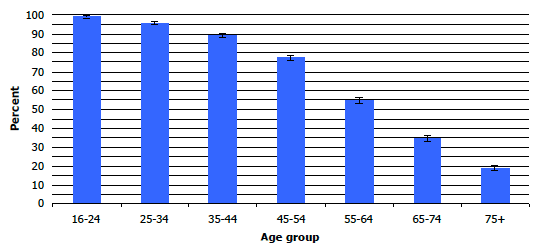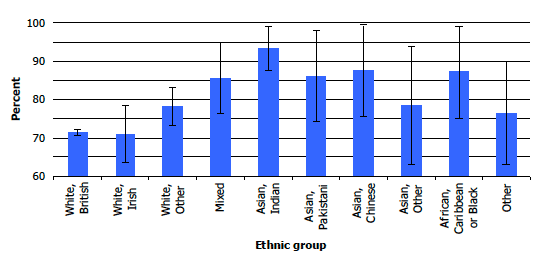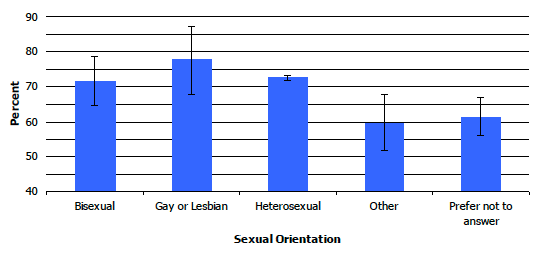Scottish Health Survey - topic report: equality groups
Topic report in the Scottish Health Survey series providing breakdowns of key health behaviours and outcomes by gender, age, ethnic group, religion, disability and sexual orientation.
3 Dental Health
Summary
- Men were slightly more likely than women to have 20 or more natural teeth.
- As age increased, the proportion of adults with 20 or more natural teeth declined and the prevalence of toothache reduced.
- White British and White Irish were the least likely of all ethnic groups to have 20 or more natural teeth.
- Muslims, Hindus and Buddhists were the most likely to have 20 or more natural teeth.
- Disabled people were less likely to have 20 or more natural teeth and more likely to have experienced toothache than those without a disability.
- Respondents who preferred not to disclose their sexual orientation, and those who reported their sexuality as 'other' were significantly less likely to have 20 or more natural teeth than the national average.
3.1 Measures of dental health
Respondents were asked how many natural teeth they had and those with natural teeth were asked whether they had experienced toothache or mouth pain within the last month.
3.2 Dental health by gender
There was a small, but significant difference in the proportion of men (73%) and women (71%) who had 20 or more natural teeth. There was no significant difference in the experience of toothache between men and women. 13% of both men and women had experienced toothache in the previous month.
3.3 Dental health by age
Dental health has a strong, linear association with age. Almost all adults aged 16-24 (99%) had 20 natural teeth or more compared with one in five adults over 75 (19%).
Figure 3A: Proportion of adults with 20 or more natural teeth, by age, 2008-2011 combined

Prevalence of toothache in the previous month was inversely associated with age. Younger age groups were more likely to report having experienced toothache in the last month with 18% of 16-24 year olds reporting this compared to 7% of those aged 75 and over.
3.4 Dental health by ethnic group
White British and White Irish ethnic groups had the lowest proportion of adults with twenty or more natural teeth (both 71%). Indian (93%), Chinese (88%), African, Caribbean or Black (87%) Pakistani (86%), Mixed ethnic groups (86%) and White Other (78%) all had significantly higher proportions of adults with twenty or more teeth than the national average.
In terms of toothache, there were few significant differences between ethnic groups. Pakistani respondents had a significantly higher prevalence of toothache (24%) than the national average whilst White Irish respondents had a significantly lower prevalence (8%) of toothache.
Previous studies of dental health in Scotland found that African and African-Caribbean people were more likely than the general population to brush their teeth twice a day and to have their own teeth.1
Figure 3B: Proportion of adults with 20 or more natural teeth, by ethnic group, 2008-2011 combined

3.5 Dental health by religion
Religious faith appears to have a strong association with how many natural teeth respondents have. Only 69% of Roman Catholics had 20 or more natural teeth, which was significantly lower than the national average of 72%. Muslims were the most likely to have twenty of more natural teeth (95%) followed by Hindus (93%) and Buddhists (89%).
There was no significant association between toothache and religion.
3.6 Dental health by disability
Dental health was associated with disability. 65% of people with a limiting long-term condition had 20 or more natural teeth compared with 75% of those with no longstanding condition.
Disability was also associated with the experience of toothache. 19% of respondents with a limiting long-term condition reported having experienced toothache in the last month compared to 11% of those without a condition.
3.7 Dental health by sexual orientation
There were no significant differences in the proportion of heterosexual, lesbian and gay, or bisexual respondents who had 20 or more teeth. Those who preferred not to disclose their sexual orientation, and those who reported their sexuality as 'other' were significantly less likely to have 20 or more natural teeth than the national average, with 61% and 60% respectively. There was no significant association between toothache and sexual orientation.
Figure 3C: Proportion of adults with 20 or more natural teeth, by sexual orientation, 2008-2011 combined

Contact
Email: Julie Ramsay
There is a problem
Thanks for your feedback